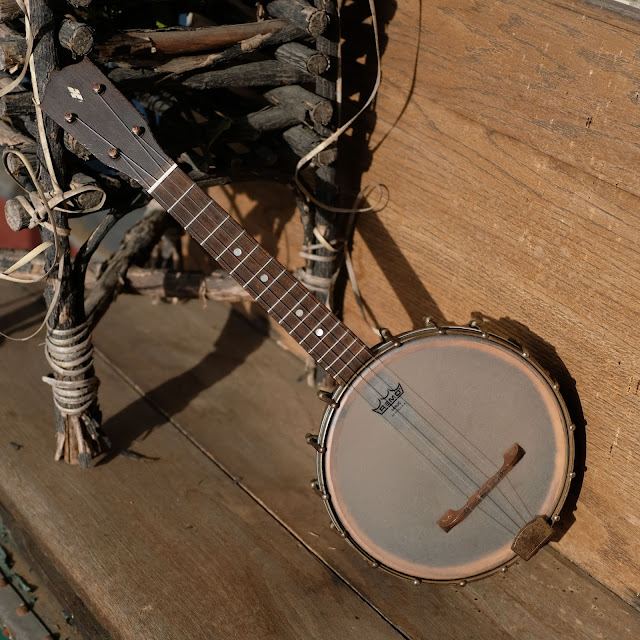1920s Stromberg-Voisinet (Kay) 8" Banjo Ukulele
This banjo uke is pretty typical of the 8" rim Kay/SV-made instruments from the '20s. It originally would've had a resonator (as evidenced by a keeper-thread in the dowel), but that's long missing. I really, really like this type of banjo uke as they mix several good elements -- a quick and comfortable neck, longer 14" soprano scale, bigger 8" rim, and good placement location of the bridge on the head. Therefore, even with a plain-Jane, non-tonering rim design, they push out a lot of volume and a good, sweet sound.
This particular banjo uke came in via a customer's pile of project banjo ukes. I gave it a new Remo Renaissance head, cleaned it up, gave it a fret level/dress, new nut, replacement (period, weirdo) bridge, and set it up. It has some definite wear-and-tear but plays (and sounds) great. Action is spot-on at 1/16" at the 12th fret and I have it strung with Martin fluorocarbon strings.
Having a modern, synthetic head is pretty nice. You get good pop, volume, snap, and warmth out of these Renaissance ones and you'll barely ever have to adjust head-tension.
The nut is 1 1/4" in width, the neck has a mild-medium soft-V shape, and while the neck seems to be poplar, the board is ebonized maple.
This has original pearl dots and I've added side dots, too.
The bridge is an interesting one I've wanted to use for a while. It's just a hair shy of 5/8" tall and was originally a 1920s banjo-mandolin bridge. I filled the old string-slots and re-slotted for jo-uke spacing. It's made from mahogany which is lightweight and it has a wide stance which keeps the tension from pressing-in on the top too much. I liked the sound of it better than a "normal" Grover-style bridge on this -- it seemed to add a bit of extra "air" to the sound.
As usual, I've stuffed muting-foam underneath the tailpiece cover to cut-down on overtones.
The original friction pegs were beat-up so I used these Lyon & Healy, same-period friction pegs instead. These hold well (for friction pegs) and turns smoothly.
Please excuse my clumsy neck attachment -- I removed the original screw-tightened neck brace and instead pre-drilled and installed a "bolt-style" attachment. It's a lot more secure and a lot more straighforward for the average player.
Note that there's a threaded attachment bit at the center of the dowel that would've been a helper for mounting a resonator. There's a small, tight, hairline crack in the dowel right at that location, but it's not effecting the instrument, so has not been reinforced. The dowel is just window-dressing at this point, as the bolt-attachment for the neck has taken-over most of its usefulness.
The foam shoved-up under it, again, mutes overtones for a drier sound.
The tailpiece is original and takes loop, tied, and ball-end strings.














Comments